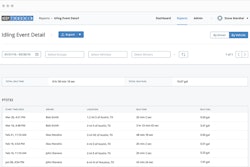On the surface, purchasing tires seems to be a rather simple transaction. Typically fleets run a few comparative tire tests and stick with that proven tire and tread design.
With tire and truck technology changing so rapidly, historical data may no longer be the best way to select tires. By the time a full tire life cycle analysis can be completed the tire compounds, designs, and performance of newer products have changed. Therefore, tire testing should be a continuous process to measure tire life, retread ability, traction, fuel efficiency, and overall cost, however emphasis must be given to the new product developments and warranties.
The OE tire manufacturers do a good job educating fleets on their tire line up and matching their recommended tire options to the fleet’s usage application. Most tire manufactures publish an application and data book about their tire offering. Typically tires are categorized by vehicle application — urban, city, regional, and linehaul.
There are several key factors you need to consider when evaluating which tires are right for your fleet.
- Dealer and manufacturer relationship/selection: The supplier can play a major role in the success of your tire program. The supplier selection process should consider dealer inventory levels, delivery turnaround time, retread turnaround, casing controls, warranty filing for both cap and casings, emergency service dispatch time commitment, service pricing, and proper failure analysis. Both the manufacturer and the dealer can assist you with technician tire training, including proper repair techniques, pressures, tire selection, and more. Work with both the dealer and manufacturer on developing repair rules for the number and size of section repairs, nail hole repairs, casing age, retread selection rules for various tires and conditions that match your appetite for savings and risk. Tire OEs and many dealers have a wealth of knowledge and resources available. The key is to develop a relationship with both the OE and the dealer and leverage their resources. Too many fleets underutilize the resources at their fingertips.
- Appetite for fuel economy: Because of the new technology and engineering that went into developing fuel-efficient tires, they come with a higher initial price. But that price can be quickly offset by the reduction in fuel consumption. Comparing the most fuel-efficient tire to a standard tire can result in a 3% to 10+% savings. To help you with this decision, many tire data books provide the rolling resistance coefficient rating. You need to determine how important fuel economy is and factor that into your decision making criteria.
- Appetite for failures on the road: No one wants a truck to fail on the road, but for some fleets, downtime can be catastrophic. In these cases a couple thousand dollars in added tire price is well worth the lower failure risk. In other cases road failures may not really be that critical. In these cases you may elect to take advantage of lower priced tires, with the full understanding that the tires may wear quicker or be more prone to failure.
- Ability of tires to be retread: The tire selection process should also consider recap ability of the casing and the warranty provided by the manufacturer —even if the casing has been retreaded. I’ve seen a lot of missed warranty opportunities on failed casings after they have been retreaded. A lot of fleets think the casing warranty expires once it’s worn out. Some new tires have a casing warranty that can extend seven years and up to three recaps. The number of retreads and the weight of the retreads planned should be considered in the new tire selection. If retreads are only used on trailers and only one retread per casing in a seven-year life, the risks are lower than a casing used for a couple heavy-drive retreads. The new tire decision should consider the number and weight of the retreads planned. The more retreads a casing has and the weight of those casings dictate the quality of new tires needed. Fleets that only use original tires should consider the casing value at the end of the tires life. Quality tier one premium casings can have significant value and some lower tier tires may not have any value at all.
- Vehicle Life Age and Mileage: Special attention should be placed on the vehicles remaining life. You don’t want to put high priced premium tires on a unit if you plan to sell it in 50,000 miles and you don’t have an outlet to swap tires around with other units. Be sure premium tires with high tread depth aren’t given away at the time of sale. When purchasing tires, fleets need to have a plan to meet the minimum trade terms for both the casing and tread depth and plan to give away no more. If you are disciplined and if it’s an option, tires can be swapped around with other vehicles in the fleet at the time of sale. If swapping tires at the time of sale is not an option and the tolerance for failures is high, a lesser quality and lower priced tire may be a viable option.
- Weight carrying capacity: Just because a tire fits doesn’t mean it meets the weight requirements. When purchasing, installing, or swapping tires consideration must be given to the axle weight rating and the tire weight rating. It’s very easy for a technician to grab a tire off the rack that’s the same size and tread design as the one being replaced. It could, however, be under rated for the axle requirement. Take a low profile 22.5 steer tire that has a “G” rating with a maximum load capacity of 6,200 lbs. (typically used for a standard 12,000 lb. front axle). Swapping steering tires with another unit with low profile 22.5 “H” rated tires from a unit with a 13,300 lb. axle can have serious consequences. Fleet managers and technicians must remember to look on the side of the tire for the load rating to make sure it meets the axle rating requirement.
Failure to consider all of the above in the tire selection process can result in increased tire cost, more tire failures, and an increased risk for a blowout.










